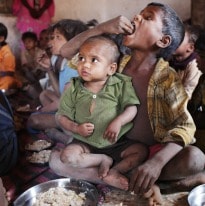While most of the country celebrates India's 68th Independence Day, a large part of it suffers in silence. This report doesn't intend to dampen the high spirits of people looking forward to a long weekend, but simply to point out a dark and undeniable truth. India is a malnutrition hotspot, one where half of its children are known to be chronically malnourished.According to the World Health Organization (WHO), out of the 20 million children worldwide afflicted with severe acute malnutrition (SAM), India is home to 8.1 million SAM children. (More: Indian scientists design therapeutic food to fight malnutrition)In an attempt to highlight the seriousness of this issue, the Centre for Public Policy (CPP) released a statement focusing on malnourishment as one of the biggest evils our country faces today. The report goes on to reveal some shocking statistics: around 1500 children under the age of five suffer and die from malnutrition every day. Indian children are affected by malnutrition 20 times more as compared to children from other countries.
These shocking statistics seriously call into question current government strategies and schemes that have been deployed to provide adequate food and healthcare to women and their children. Some statistics from the UNICEF report: In Bihar, the proportion of under-weight children is nearly 50%, in Andhra Pradesh it's 37%, in Uttar Pradesh it's 36% and in both Rajasthan and Chhattisgarh it's 32%. Moreover in Delhi, 35% of the nearly 7 lakh children, attending anganwadis were found to be underweight, which is an absolutely appalling number. Although a number of efforts have been made to ensure food security to India's 1.27 billion people, the current scenario makes us question whether it's enough. Malnourishment deserves far greater attention and investment on part of the government and from those who are more fortunate. The government should allocate funds that can cover free meals and maternity benefits for pregnant women and lactating mothers. They should also be able to provide free meals to children between the ages of six months and 14 years, and homeless people.The policymakers need to look at the seriousness and the scale of child malnutrition problem in order to make India a healthier and stronger nation. The Lancet series stated that India does not even have to look far to see progress. If India succeeds in eliminating under nutrition in young children, it can boost the Gross National Product (GNP) up to 11%. An excellent example of this is the state of Maharashtra that has managed to reduce the percentage of malnourished children from 39% to 23%. This could be seen as a small yet commendable accomplishment that will pave way to a healthy nation. The Centre for Public Policy (CPP) suggests that in order to reduce the child mortality rate and malnutrition, there needs to be some basic malnutrition awareness programs in place where experts can help people understand basic nutrition guidelines. Strengthening village level government facilities and implementing innovative practices will also have a positive impact on things.The need of the hour is not just economic growth but a framework which brings together developments in all key areas, one that calls for a stronger commitment towards social work and creates opportunities for self-reliance.
These shocking statistics seriously call into question current government strategies and schemes that have been deployed to provide adequate food and healthcare to women and their children. Some statistics from the UNICEF report: In Bihar, the proportion of under-weight children is nearly 50%, in Andhra Pradesh it's 37%, in Uttar Pradesh it's 36% and in both Rajasthan and Chhattisgarh it's 32%. Moreover in Delhi, 35% of the nearly 7 lakh children, attending anganwadis were found to be underweight, which is an absolutely appalling number. Although a number of efforts have been made to ensure food security to India's 1.27 billion people, the current scenario makes us question whether it's enough. Malnourishment deserves far greater attention and investment on part of the government and from those who are more fortunate. The government should allocate funds that can cover free meals and maternity benefits for pregnant women and lactating mothers. They should also be able to provide free meals to children between the ages of six months and 14 years, and homeless people.The policymakers need to look at the seriousness and the scale of child malnutrition problem in order to make India a healthier and stronger nation. The Lancet series stated that India does not even have to look far to see progress. If India succeeds in eliminating under nutrition in young children, it can boost the Gross National Product (GNP) up to 11%. An excellent example of this is the state of Maharashtra that has managed to reduce the percentage of malnourished children from 39% to 23%. This could be seen as a small yet commendable accomplishment that will pave way to a healthy nation. The Centre for Public Policy (CPP) suggests that in order to reduce the child mortality rate and malnutrition, there needs to be some basic malnutrition awareness programs in place where experts can help people understand basic nutrition guidelines. Strengthening village level government facilities and implementing innovative practices will also have a positive impact on things.The need of the hour is not just economic growth but a framework which brings together developments in all key areas, one that calls for a stronger commitment towards social work and creates opportunities for self-reliance.
Advertisement










